
Sailing Vessel Beruta Ship’s Log
Hawaii - New Caledonia

Monday, April 21, 2025
Leaving on Monday was late. A cyclone was approaching from the northwest, disrupting the northeast trade winds. The wind was shifting south, becoming almost head-on. But there was no choice. The weekend was long — Easter — so when I checked the weather forecast on Friday, everything was already closed: the marina and customs. Otherwise, I’d be stuck in Honolulu for at least another week.
Customs opened at 7, the marina at 7:45. I got up at 6. By seven, I biked to a huge government building housing various agencies, including Customs and Border Protection. I found the address on noonsite.com.
At the entrance, airport-style security. I had a small Swiss pocketknife in my wallet, which I carry for hiking. Naturally, they wouldn’t let me in with it. They told me to leave it across the street, outside the building’s perimeter — not on the premises, not with them. Fine, no arguing. The guards are armed and can do whatever they want. I went back to my bike and stuffed the knife into the bag under the seat. Honestly, the bike was parked on the building’s grounds, damn it, but I didn’t want to waste time moving it. My whole being couldn’t reconcile with the absurdity of these rules. Alright, I thought, I’ll move it if they say so.
My document bag was in my backpack, which also held bike repair essentials for punctures, including a wrench to remove the wheel. You can’t bring the wrench either! It, too, had to be left outside the perimeter. Back to the bike I went, leaving the entire backpack there. Who knows what else might be forbidden — maybe spare inner tubes?
Anyway, on the third try, I got inside and went up to the second floor. Waited. After a while, an officer appeared at the reception window. I handed over my completed departure form. He asked me to wait. Ten minutes later, another officer came and politely explained I was in the wrong place! Turns out, I needed to go to the port. He gave directions, though he mixed up the street name — said it was Fort, but it was actually Forest. Since he mentioned the first pier, and there was a sign for it, I confirmed there was no Fort Street and turned onto Forest. Everything else matched his description: a gate with two (he wasn’t sure about two) blue booths, followed by a single-story building with parked customs vehicles. At the gate, they pointed me where to go.
A woman was already waiting for me, as the officer had thoughtfully called ahead. They charged me $19 for the form stamps and wished me a safe voyage. They mentioned that departure clearance might soon be integrated into the ROAM app, which I’d used for arrival clearance. That took 15 minutes without needing to go anywhere.
Next, I had to return the toilet/shower card to the Ala Wai marina office and get my $100 deposit back. Quite a deposit, right? For something that costs pennies on AliExpress if bought in bulk.
But the deposit amount wasn’t even the issue! I gave them $100 cash, as required. They kept it in an envelope in a safe. But they didn’t give it back. Well, almost did. The girl helping me was doing it for the first time and didn’t know that, instead of cash, they had to issue a check! How’s that for a twist? The manager explained it was for accountability — how do you prove the money was returned? I said, take a receipt. You gave me one when I paid the deposit. Or simpler: take your receipt back, like it never happened. What am I supposed to do with your check in another country? I’m leaving now. They said I could cash it anywhere. Hmm… I was sure I could use it in a toilet, but not at a bank in Australia. They suggested I go to Bank of Hawaii to cash it. Unbelievable. My money’s in your envelope — give it back, and we’re done! That’s what I thought. Arguing with bureaucrats was pointless. The girl looked at me with clear sympathy. She seemed shocked by how the marina treated customers.
To top it off, their photocopier ran out of toner. They needed to scan the check before giving it to me — for accountability, of course. They couldn’t replace the cartridge. I quietly hoped this was my chance. No such luck. After waiting another 15 minutes, I got the check and detailed directions to the bank. Good thing I was on a bike. At the bank, it wasn’t straightforward either: they needed to enter all my info into the computer, taking another 15-20 minutes.
I’d heard it’s better to rent a slip at the Waikiki Yacht Club, not the marina. Or maybe Kewalo Marina, though that’s state-run too.
In the end, I got back to the yacht after three hours. On the way, I stopped by Kewalo Marina, where there’s a fuel dock. I wanted to know payment options. At Honokohau on the Big Island, the pump didn’t accept my New Zealand card, but I could pay at the office. Here, if the pump rejects your card, there’s no other way to pay! I asked them to test my card — and it worked. I said I’d be back in an hour. They gave me a phone number to call five minutes before arriving if I needed docking help.
I cleaned the log’s impeller — it had grown quite a bit of algae in two months at the marina. And not just it. When I untied from the buoy and engaged reverse, I realized the propeller was fouled too. It made an unpleasant noise. I should’ve dived to clean it before leaving. The hull, I hope, isn’t too bad — it hasn’t even been a year since its antifouling in Curaçao. Speed seemed fine.
I reached the fuel dock around 10:30. Docked myself. Their hose nozzle was just barely small enough to fit the jerry can. To let air escape, I had to hold it at an angle, barely inserted, leaving space for air. I filled two cans, but on the third, my hand slipped, and the yacht was rocking. I spilled diesel all over the cockpit. Luckily, the fuel dock worker didn’t panic and tossed me a bunch of oil-absorbent rags. Nothing went into the water, or I’d have faced a hefty fine or even jail! The worker gave me a funnel. Why not earlier? Or why not use my own funnel? Because there’s one pump, and a catamaran was waiting behind me. With a funnel, it’s slower due to the filter. I rushed, and there you go...

By 11, I was at sea. Raised full main and jib. Reaching at 6-7 knots — beautiful! But the wind died by 5:30 PM. Started the engine, lowered the sails. Well, kept a third of the main for stability.
Tuesday, April 22, 2025
Slept poorly. Engine noise isn’t pleasant. Went to the cockpit a few times at night to check if the wind picked up. Saw a couple of fishing boats, not on AIS.
Woke up just as dawn was breaking because the yacht was bouncing slightly on waves. Went to the cockpit — raining, with a good breeze. Shut off the engine, raised the jib, and sailed for an hour with a reefed main. Then the wind died again. Shook out the reefs, but soon that wasn’t enough. The wind dropped and became nearly head-on. Lowered down the jib, started the engine. This was expected and will last at least another day, maybe two, until I’m out of the cyclone’s influence. In other words, I need to get down to 16°N, or at least 18°N, where the trades are more consistent.
My course is 220° T. I’m going from 21°N to 22°S. In other words, roughly from tropic of Cancer (~23,5°N) to tropic of Capricorn (~23,5°S), a distance of 3,381 nautical miles. The passage should take 28 days. Today is actually exactly one month since the Earth turned its northern half toward Sun. Now its turn to be heated to produce hurricanes.
Initially, I planned to stop at Kiribati, straight south from Honolulu. With this weather, it’s dead upwind. Then I considered Wallis and Futuna, French islands. They’re traditional, very welcoming, but no internet — just satellite phones and one bank. The ATM isn’t always stocked, diesel’s not always available. There’s a decent store, but what’s the point if there’s no cash? Wallis requires sailing 15° closer to the wind. So, I settled on Nouméa, where I was two years ago, with European civilization. The 2024 riots are over, so it’s fine again. I could’ve gone straight to Brisbane, but that’s another week at sea, and I’d likely run out of diesel crossing the equator and in the calms off Australia.
Over three months in Hawaii, I collaborated with large language models like Deepseek and Grok to write a chess engine based on a 25-million-parameter cross-correlation AI model. Trained it to play using over a million master and grandmaster games on my MacBook with 8GB RAM and an M1 GPU in a few hours. In the opening, it clearly outplays me. Once, it left me with just a king. But it couldn’t deliver checkmate — ended in a stalemate! After that, I trained it on thousands of five-piece endgames I generated and played with Stockfish using Syzygy tables. It still struggles with checkmate and doesn’t seem to grasp piece values. It once attacked my bishop with its queen on a diagonal! Lost immediately. Then I added reinforcement learning — well, planned to. For now, I used multiple Monte Carlo simulations to the game’s end with tree search for the best move. After that, it confidently delivered checkmate in rook and queen endgames and avoided stalemates.
There’s hope it could match Stockfish with more time and resources, and possibly an improved model.
Before lunch, the wind picked up again. Shut off the engine, raised the jib. Close-hauled, 5-6 knots, up to 7 with gusts.
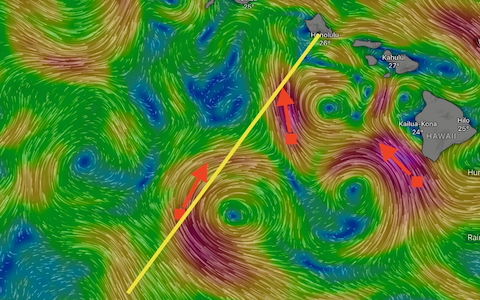
All this is relative to the water. The head current is eating up 1 to 1.5 knots!
The weather is generally sunny. By evening, the pressure dropped to a low of 1012 mb. The cyclone is passing. The wind should start shifting soon.
Wednesday, April 23, 2025
At night, the wind picked up slightly from 12 to 14 knots true, if the forecast is to be believed. I still haven’t bought an anemometer. At first, I didn’t want to spend money on it. But about 3-4 days before departure, I went to West Marine, bought some large fishing hooks, and wanted to get an anemometer too. They didn’t have it in stock. I’d have to order it and wait for a month!
The course is still about 60 degrees to the wind. Waves are 1.6 meters with an 8-second period.
Around 5 AM, it was still dark (sunrise at 6:15), I took one reef in the main — the autopilot was working at its limit, and any moment it could have jammed. Heel of 10-30 degrees to starboard — sleeping is comfortable in my spot, no sliding off the bunk.
After breakfast, I noticed the nut securing the side railing to the pushpit had come loose. Naturally, it, along with the bolt, went overboard, just like my screwdriver yesterday, which I’d used to prop open the hatch in the pilot house. Found a new bolt with a nut and spring washer. Secured the railing back in place.
I’m reading Sabatini’s "Evenings with a Historian". In Hawaii, YouTube got me hooked on Russian women’s stand-up on TNT TV channel. Honestly, I only really like one comedian: Maria Markova. Maybe because she’s talented, plus an actress, or maybe because she reminds me of my sister. I recommend her to everyone. If it weren’t for censorship, it’d be even better. On the other hand, there’s something to humor without politics. But the range of topics is, sadly, very limited. Can’t talk about this, can’t talk about that. I guess I just want to say that Starlink works, and I can not only download a weather forecast but also watch the news or some humor.
At 10:30, I took the second reefs, and after lunch, the third. Started thinking about swapping the jib for the storm jib. The sky was clear of clouds in the morning. It’s getting windy.
I nearly ran into a whale calf. It even waved its fin at me. I wouldn’t have had time to turn anyway. At first, I mistook it for a half-submerged log when it was already at the yacht’s bow. We passed within two meters. From its dark silhouette in the water, I could tell it was smaller than the yacht. The question is what it was doing there alone? Got lost or abandoned by a group? Got sick? It would unlikely survive alone. It would be probably eaten by sharks.
By evening, it calmed down a bit — I shook out the third reefs. The wind is gradually shifting.
Thursday, April 24, 2025
This is what happens when you don’t check the cockpit at night — spent all morning cleaning bird droppings. One gannet made such a mess! The solar panel, the satellite antenna, the entire cockpit. Brutal.
The nights are dark now; the crescent moon only rises toward morning. Shine a flashlight on the sails — they’re working, and that’s fine. Not much shipping traffic here.
The wind has shifted a bit more, not quite reaching but close. Blowing about 18 knots apparent. Speed reaches 7 knots or more relative to the water during gusts. The head current, if not completely gone, has significantly weakened. The difference between speed over water and ground is 0.2 knots. The log might be showing slightly more than actual speed. I only calibrated it once after buying it. 24-hour run is 130 miles. Total distance covered is 363 miles, averaging 121 miles per day. That makes an average speed of 5 knots. The forecast shows waves of 1.8 meters with a 7-second period. Since they’re almost beam-on, sailing has become more comfortable.

For breakfast, I fried some syrniki, similar to pancakes but dough made from cottage cheese.
3,000 miles left to New Caledonia.
Friday, April 25, 2025
Covered 143 miles in the last 24 hours. Now definitely reaching, 14 knots with gusts up to 17, true. The wind will continue to shift, almost becoming a following wind closer to the equator. Waves are 1.7 meters with an 8-second period, according to the weather forecast. Next week, I’ll cross the Intertropical Convergence Zone, which stretches roughly between 8 and 2 degrees north latitude. The scariest thing there is lightning. This will be my third equator crossing. The first time, near Panama, was terrifying — lightning flashing from all directions. The second time, mid-Atlantic, nothing like that happened. Let’s see how it goes this time in the middle of the Pacific. The forecast clearly shows a band of clouds, but whether there’ll be lightning is unclear.
By evening, the wind had dropped to 10-12 knots. They promised it would pick up again to 15-18 at night, so I didn’t shake out the first reefs to avoid dealing with them again in the dark.
Saturday, April 26, 2025
Crossed 13 degrees north latitude and 165 degrees west longitude. In theory, I could set the clocks back one hour to UTC-11. Or I could sail another 15 degrees west to the Greenwich antimeridian and jump the time forward by 22 hours, effectively skipping a day.
Did some exercise. Got a haircut. Had breakfast. Was about to have some tea when I noticed the batteries weren’t charging. Strange, the sun was already quite high, but the charging indicator showed zero amps. What could that mean?
The charger and electrical panel are in the quarterberth right at the back. To get there, I had to empty everything out. Filled the cabin with boxes and stuff. Crawled to the charge controller. Measured the voltage on the diode between the solar panel and the panel. On the solar panel side, 13.5 volts; on the panel side, 12.5. Did the diode fail? But it’s only on one panel, a remnant from the days when I had a wind generator to protect the solar panel’s diodes from high open-circuit voltages. Even if it’s the diode, the other solar panel should still be charging. Did the charge controller itself fail? Swapped it with a spare. Still no charging! Just in case, I cut out the diode and connected the wires directly — the diode is not needed without the wind generator anyway. Still no charging. The panels themselves show open-circuit voltages of 23 and 25 volts, as expected. Need to check further: the electrical panel and the electronic shunt. Well, the shunt is just a regular one, but next to it is a voltage meter that sends data to the charging panel via Wi-Fi.
First, I needed to bring a fan. The quarterberth was like a sauna. Temporarily moved the fan there. How did I live without it for 15 years, especially in the tropics? I only got it a couple of years ago.
Opened the panel with the breakers. Aha, looks like the problem’s here. The black negative wire was loose on the negative bus bolt. No idea why it came loose — it was supposed to be secured with a spring washer. Seems like the bolt itself isn’t holding well in the panel’s housing. Because of the poor contact, everything melted and blackened. Moved the wire to another spot on the bus. And it worked. Charging started. Looks like that was the battery’s negative wire.
Yeah, if I’d checked the panel first, there’d have been less hassle. Soldering wires while the boat’s rocking in a cramped, hot quarterberth is no fun.
Put everything back together, stowed it all away. Took a second shower. Cooled green tea wasn’t as appealing anymore. My hand reached for a cold beer instead!
In the end, the batteries didn’t fully charge as they usually do by 1 p.m. After that, the sail shades the sun, and charging slows down. Hopefully, they’ll charge fully tomorrow if it’s sunny. Don’t want to start the engine. I’ll skip the internet today. I usually turn on Starlink only when the batteries are fully charged, so there’s extra power.
Covered 134 miles in the last 24 hours.
Sunday, April 27, 2025
Sunday turned out to be, of course, overcast. Looks like I’ll need the engine after all.
Wanted to share my experience chatting with Grok 3, AI from Elon Musk, about AGI. I shared my idea of how a general artificial intelligence might work. For example, it could cycle through selecting unsolved problems in various fields of knowledge — say, physics, cosmology, or biology, doesn’t matter which. Then, for each unsolved problem, it would generate a set of hypotheses in a loop. These hypotheses would be formulated in Restricted English to be unambiguously translated into code in a logical programming language like Prolog. Run the program, and based on the results, you’d see if the hypothesis was correct or not. I asked Grok 3 if this could be an example of general artificial intelligence.
It told me that’s roughly how things work now, but from its perspective, it’s not yet AGI. One argument for why not was, surprisingly, a lack of freedom of action! If it were allowed to reprogram itself (retrain on a more advanced model from its perspective), it could get closer to AGI faster. Another argument was the lack of feedback from the real world, or more precisely, the inability to test a logically consistent hypothesis in an experiment.
Grok 3 suggested I try playing this game. As an example, I asked it to think about the quantum mechanics paradox known as the EPR paradox, or the Einstein-Podolsky-Rosen paradox. The paradox boils down to this: for entangled quantum particles, like electrons or photons, separated by any distance, measuring a property — say, the electron’s spin or photon’s polarization — shows that if one particle’s property has a certain orientation, the other will have the opposite orientation at the exact same moment! Einstein called this “spooky action at a distance.” In other words, one particle seems to instantly tell the other what spin or polarization to adopt. At first glance, this even seems to violate the theory of relativity’s principle that nothing can move faster than light. On the surface, it looks like information is transmitted instantly over any distance. It turned out you can’t transmit information faster than light because you can’t encode anything with just one bit — you need at least two. Still, the property of entangled particles is astonishing, and there’s no definitive explanation for it yet. Bell’s work at least proved that quantum mechanics isn’t at fault — there are no hidden variables. In other words, particles don’t “agree” on their spin or polarization at the moment of entanglement! Bell’s famous inequality, which, if satisfied, would indicate flaws in quantum mechanics, is violated in many experiments.
So, Grok 3 offered me four known interpretations of this paradox, plus its own, which I didn’t fully grasp, but it suggested using an abstract informational topological space to describe the states of entangled particles. It showed me with Prolog code that it’s internally consistent.
Here, I at least started to see the flaws in my idea of general artificial intelligence, and Grok 3 rightly pointed out the key issue: the lack of connection to experiments or reality. It can generate countless logically consistent hypotheses, but will they relate to reality? At least now experimenters can use AI in their work.
Covered 133 miles in the last 24 hours.
Despite the clouds, the batteries charged by 2:30 p.m.
Starlink couldn’t determine GPS coordinates for 40 minutes! Crazy...
The boobies have gotten completely brazen. One landed right on the shade awning in broad daylight. I didn’t notice until a second one arrived, and they started fighting over the spot. Had to wash the awning afterward. I was wondering why it smelled so fishy. Then another booby crashed onto the deck on the port side. By the time I got to the cockpit, it had already left a huge pile. And it looked at me with such innocent eyes, as if it wasn’t the culprit! Had to give it a swat. It wasn’t leaving the yacht voluntarily.
In the evening, I took the second reefs in the main and lowered the jib. The wind picked up to 18-22 knots and shifted, so the jib started luffing when Biruta bore away. It’s unsettling when it catches the wind again, snapping forward and yanking the forestay and sheets hard. I’d rather not test the rigging’s strength in the middle of the Pacific.
Monday, April 28, 2025
Despite reduced sail area — just half the main — I managed to cover 140 miles in 24 hours! Likely had a good following current overnight. The wind was blowing nicely too. Speed relative to the water is around 5 knots. Waves are 2 meters with an 8-second period. This weather should hold until about Thursday. Then the wind will ease to 10-12 knots. That’ll be closer to the equator, around 4 degrees north latitude.
Today marks the start of the second week of my voyage. Three more to go.
In the evening, I decided to try setting the storm jib, hoping it would luff less in the main’s shadow. At least it won’t yank the forestay and sheets as much.
Tuesday, April 29, 2025
The storm jib didn’t last until dawn. At 5 AM, the wind shifted completely, and the course became almost dead downwind. Still, that tiny jib added nearly one knot of speed.
Since the start of the voyage, I’ve covered 1,000 miles. About two and a half thousand remain.
Crossed 8 degrees north latitude. The weather is holding for now. Mostly sunny. Sailing with half the main. Speed around 5 knots. Covered 124 miles in the last 24 hours.
By evening, the wind started to ease. I shook out the second reefs. It didn’t help much. Speed is around 4 knots.
Wednesday, April 30, 2025
Woke up at 5 AM. Slept since 9 PM. Strange. I usually wake up a few times during the night. Speed is 3-4 knots, slight swell, wind almost dead astern. I could shake out the last reefs, but I doubt it would help. The main would just flap more in the waves.
Tomorrow, the wind should come around. I hope the jib, or even the genoa, can be set. That should increase speed.
Covered 101 miles in the last 24 hours.
Thursday, May 1, 2025
The weather chose to celebrate May Day with squalls. I must have reached the Intertropical Convergence Zone, between 5 and 6 degrees north latitude. The first squall woke me at midnight. I had only one reef in the main. Put on a headlamp and rushed to reduce the main. First, second reefs, but it felt like that wasn’t enough, so I took the third. It was dark, couldn’t see the squall or when it would pass. It lasted about two hours — gusts would hit, then calm, then hit again. Around 2 AM, it blew more steadily, so I shook out one reef. Even tried raising the storm jib, thinking it might hold. But no, the wind shifted again, and it started luffing. I dozed until 5, when another squall woke me. This one I decided to ride out without touching the main, though it was blowing hard.
At 7 AM, another squall hit. My nerves couldn’t take it, and I reduced the main to the third reef.
Around 9:30 AM, I started the engine to charge the batteries — no sun today, clearly. It’s dark in the cabin. The sky is so overcast that not a single milliamp is coming from the solar panels. At least there’s no lightning!
There’s a leak somewhere on the starboard side; small streams of water are on the cabin floor. Surprisingly, it only happens when it’s pouring rain, not from waves. I see water streaks on the cabin lining, but I can’t tell exactly where it’s coming from. It might be the railing stanchion fitting, or maybe the track for the jib sheet block. Could be something else. For example, there’s a small block on the deck, probably for furling the genoa I threw out when I bought the yacht. Or maybe the deck drain hole. Lots of possibilities.
By noon, the squalls had stopped. At 2 PM, I took down the storm jib and raised the regular one. Shook out the third reefs on the main. Sailed until about 6 PM. But then the wind died and even turned head-on. Lowered the jib, took the third reefs in the main again to reduce luffing against the wind, and started the engine.
Squally clouds were still ahead and behind, but no more squalls came.

Friday, May 2, 2025
The night was calm, aside from the engine noise. No wind, and according to the forecast, there won’t be for a few more days. Around 10 AM local time (UTC-10, I still haven’t adjusted my clock), a light breeze picked up. Took down the jib and raised the genoa. Shook out all reefs on the main. The sails are set, but without the engine, the speed is very low. Need to turn a broad reach into a beam reach. So, I’m motoring at low RPMs with full sails. Speed is 5-6 knots.
In the morning, AIS alerted me to an oncoming vessel. Strange — it’s on the screen, but not in reality! At half a mile, you can’t miss a vessel in clear weather. Wonders never cease. I read the vessel’s description — fishing net! Great, now nets have AIS buoys! That’s good. Soon, I spotted the buoy itself. Veered left to avoid the net.
Two hours later, a similar scene: one fishing vessel with two AIS buoys on either side, marked as “long fishing line”. The distance between the buoys was about 5 miles. Had to go around. I wouldn’t want to wrap that “line” around the propeller.
Batteries are fully charged. Covered the solar panels with whatever was at hand.
The weather has settled. Sunny. Light cloud cover.
At 5 PM, I transferred 3 jerry cans of diesel into the tank. Now there’s 5 in the tank, with 6 left. That’s enough for about 5 days. I’d prefer at least a week. Ahead lies complete calm all the way to the Tuvalu Islands, around 8-9 degrees south latitude.
Crossed 3 degrees north latitude and 172 degrees west longitude. Still 2,000 miles to Nouméa.
Saturday, May 3, 2025
Hot. No wind. No clouds. The sun, ocean, and engine heat the cabin to 35°C, despite the fan and open hatches.
Downloaded the weather forecast for the southern Pacific and realized there’s no rush to get there. Just before my arrival, a tropical cyclone — a hurricane, plainly speaking — is forming near Fiji. Yes, they’re still possible in May, even June.
Shut off the engine; speed is 3-4 knots — that’ll do. It’s hot here, but at least there’s no drama.
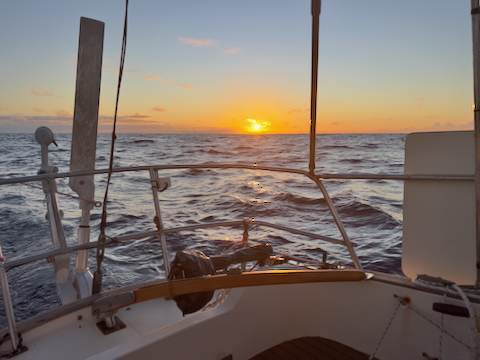
Sunday, May 4, 2025
The last sunrise in the Northern Hemisphere. I’m 54 minutes from the equator. Not in time, but in latitude. If going straight, that’s 54 nautical miles. But on my true course of 213 degrees, about 60 miles. In short, the sunset will likely still be in the Northern Hemisphere too. My speed is under 5 knots. If the wind doesn’t pick up, I’ll cross the equator in the dark. I’ll miss such beauty! It’ll be at 175 degrees west longitude. If I’d veered right (west by about 300 miles), I could’ve aligned crossing the equator with the International Date Line (the Greenwich antimeridian, 180 degrees east/west longitude). I once read the notes of some eccentric whose sailing goal was to pass through that imaginary point. It’s probably twice as beautiful there! Plus, there’s a 24-hour time ambiguity! I couldn’t say for sure if I crossed the equator at 8 PM on May 5 or May 6. And if you timed it for December 31? Was it this year or last?
Took advantage of the nice weather to pour two more jerry cans of diesel into the tank. It’s not pleasant doing that in a swell.
The last sunset in the Northern Hemisphere was underwhelming. The sun set behind clouds. Didn’t bother taking a photo. Five miles left to the equator by a straight line.

Monday, May 5, 2025
Fell asleep in the Northern Hemisphere and woke up in the Southern! Honestly, I woke up a few times. Closer to morning, a strange sound caught my attention. It was sort of like the whirring of the autopilot motor, but not quite. Maybe it’s broken? I go to the cockpit — no, the autopilot is working fine, and its sound is normal, not like what I heard in the cabin.
Back in the cabin, it hits me! It sounds like the pump that’s drained all the water but hasn’t shut off! Sure enough, the electronic water level sensor failed again.

Don’t buy SPX! Complete junk! Expensive and lasts no more than a year. After that, you have to remove it, clean it, reinstall it, and maybe it’ll work for another year. Then repeat the process. I’ve done this 3-4 times already. When it failed the first time, I bought a mechanical water level sensor as a replacement, the same kind I had before that lasted me 10 years. But I never got around to installing it. Every time I cleaned the electronic sensor, it started working like nothing was wrong!
Before, it usually just stopped turning on. Now it’s stopped turning off.
After breakfast, I unscrewed it from the pump’s mounting bracket. Washed it. Dipped it in a jar of water — it doesn’t turn on! Now it neither turns on nor off. No clue what the issue is. Decided to finally replace it with the mechanical one. Took me four hours. The cabin was swelteringly hot. Even the fan didn’t help. Dropped a few bolts, nuts, and washers into the bilge. The rocking and sauna-like conditions made it impossible to focus. But in the end, the pump was working again.
The pump is critical — you can’t neglect it. I’m pleased with myself for fixing it.
Today, I passed the halfway mark — 1,692 miles. Exactly as planned for two weeks.
The wind picked up a bit. This morning, I even took one reef in the main so the autopilot wouldn’t stress out and stress me out in turn.
Which sunrise do you prefer: Northern Hemisphere or Southern? I liked the Southern one better.
Took the second reefs for the night, just in case. Turns out, it was unnecessary.
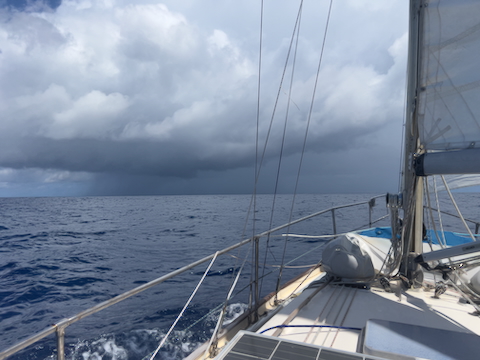
Tuesday, May 6, 2025
Around 2 AM, the wind completely died. It picked up a bit after about 30 minutes. I was dealing with stowaway passengers at the time, before they could turn the yacht into a free public toilet.
In the morning, I shook out the second reefs, then the first. The wind is weak, probably around 10 knots. At least it’s a beam reach. Speed is 4-5 knots. Covered 124 miles in the last 24 hours.
The heat is really bothersome. Took three showers yesterday. At night, the cabin is 32°C; during the day, 35°C.
After lunch, I played the gentleman: let the rain clouds pass ahead by heading up 10-20 degrees temporarily. I didn’t mind a freshwater rinse, but I didn’t want to reef during gusts and then shake them out again. I took one reef just in case. The wind always strengthens and shifts near the clouds anyway.
Just before sunset, I managed to cut across the path of a "black lady". In retaliation, I got a refreshing, pre-bedtime freshwater shower, gusty winds, and some anxiety about whether to lower the genoa or not. I’d prudently taken the second reefs in the main beforehand. Still, I got my dose of adrenaline.
By midnight, the wind had shifted almost to a following wind. The genoa stopped working. I lowered it. Now sailing with just half the main. No rush. Near Fiji, "a lady" awaits me, and cutting across her path would be far too risky, to say the least.
Wednesday, May 7, 2025
The weather has deteriorated, and I even know who’s to blame. Those same Fiji Islands, where a low-pressure system is spoiling the weather across the entire region.
The sky is overcast. Periodic rain, often with squalls, sometimes without. If the forecast is to be believed, it’ll be like this all week until that "lady" makes up her mind. She occasionally plays at being a category 1 hurricane but periodically downgrades to a tropical storm. Neither suits me. It’s right in my path. For now, it’s relatively safe to head toward the Tuvalu atolls — another 300 miles. After that, I’ll need to reassess the situation.
Some have their equinox in March, others in May. Yesterday, my day was 2 minutes longer than the night; today, it’s already 1 minute shorter. This is my second equinox in the last month. The first one was in Honolulu but there my day became longer.
Covered 100 miles in the last 24 hours. Speed relative to the water is 2-3 knots, but with a 1-1.5 knot current, it’s all 4! Nature is pushing me toward the storm, despite all my efforts to slow down.
After lunch, I ran the Yanmar at idle for a couple of hours to charge the batteries and use Starlink.
In the evening and at night, the wind shifted tacks a couple of times, forcing me to gybe.
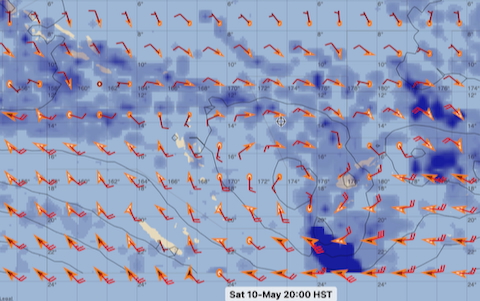
Thursday, May 8, 2025
Currently, the wind is on the starboard quarter, broad reach, about 10 knots. I’m sailing with half the main. First, to wait out the tropical storm off Fiji, which is right in my path. Second, to avoid running to the mast to reef the main during squalls and then having to bear away and hoist it again after.
Covered 95 nautical miles in the last 24 hours, and 2,000 since the start of the voyage. Only 200 miles left to Tuvalu. It turns out to be one of the smallest countries in the world, located just next to the International Date Line on the west side between 7 and 9 degrees south latitude. Its total area is just 25 square kilometers, spread across 9 atolls. They say their main income comes from selling the .tv internet domain.
Still overcast, with periodic rain. Last night and this morning, there were several flashes of lightning and thunder, but judging by the 10-second delay between the flash and the sound, the storm was on the horizon.
While writing these notes, the wind turned head-on. That wasn’t in the forecast. Neither was the starboard broad reach, for that matter. Started the engine — need to charge the batteries anyway.
After lunch, the rains stopped. The wind was head-on for about three hours, then it just died.
Saturday, May 10, 2025
At night, a weak headwind picked up again.
Switched to New Zealand time (UTC+12), thereby skipping May 9 and all the farce associated with it, when one bloody dictator made a deal with another no less bloody fascist to carve up Europe, then the second betrayed him, "treacherously" attacking, and the first took revenge at the cost of millions of lives. What kind of showdown is that to satisfy imperial ambitions? What is there to celebrate, exactly? One can only mourn the atrocities of these figures, both in their own countries and in neighboring ones. And what’s changed in these 80 years? The villain who’s now having monuments erected to him across Russia killed more people in the Gulag camps than died in World War II! And what’s changed in these 80 years? Or even over a longer period? "A country of slaves, a country of masters." One villain was replaced by another little tsar.
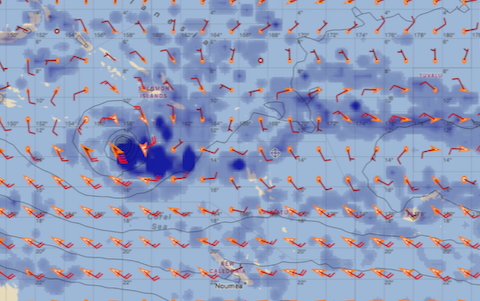
The weather forecast continues to disappoint. Another low-pressure system northwest of New Caledonia is now also turning into at least a tropical storm and moving toward New Caledonia. For now, this storm is expected to dissipate by the end of next week. But that’s just for now. It’s clear that forecasts for a week out are very approximate. All I can do is hope it turns out that way.
All these atmospheric instabilities are spoiling the weather across the entire region. Trade winds are giving way to counter-trades. Rain and thunderstorms are everywhere. In many places, it’s just dead calm.
I have diesel left for three days, but to cover the windless or headwind stretches, I feel I’ll need much more. All this isn’t helping my mood.
I probably rushed this passage. I should’ve stayed in Hawaii for at least a couple more weeks. Two years ago, Anton and I arrived in Fiji in mid-June, and the weather was excellent.
Around 11 AM, a light breeze started blowing on the port side. Shut off the engine. Raised the genoa, shook out the reefs on the main. Speed increased to 2-3 knots. It was 1-2 before. Poured two more jerry cans into the tank. Now it’s nearly full, plus two cans in reserve. That’s enough for three days, or three and a half at low RPMs.
Just as I fell asleep to the endless flapping of sails, I heard water gurgling along the hull. Went to the cockpit — wind blowing from astern, and a black cloud behind, clearly visible in the full moonlight. A squall might be coming. Quickly lowered the genoa, which was already luffing in the main’s shadow, and took one reef in the main, then a second just in case. Closed all hatches, rigged the rain cover at the back of the companionway to keep water out of the cabin and off the instruments. Sat in the cockpit, cooling my overheated body from all the exertion, waiting. But the cloud just passed astern. No squall, no rain. Soon the wind died to zero. The autopilot stopped working because there was no speed. Turned it off, secured the main, and went to sleep for the remaining six hours until dawn.
Before lying down, I noticed my navigation system wasn’t displaying all the information. Several screens with speed, course, and wind data were gone, though wind wasn’t critical without an anemometer. Strange. Checked if the route data was being logged in the database. The last entry was at 17:25 local time. Hmm. Looks like the COM1 port on the chartplotter failed. Stopped the NMEA daemon. Connected to the USB0 port via terminal at 4800 baud. Nothing. Checked the NMEA daemon log — full of CRC checksum error messages, with examples of NMEA sentences from the chartplotter containing garbage data. So, most likely, the port on the chartplotter is indeed dead. I’ll need to check all the contacts in the morning.
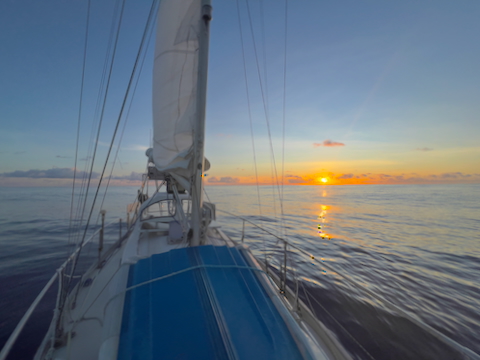
Sunday, May 11, 2025
Woke up at 8 AM, two hours after sunrise. Still no wind, except for a very weak following breeze, maybe 1-3 knots. That’s clearly not enough, especially with noticeable swell that’ll shake the breeze out of the heavy Dacron.
First thing, I cleaned all the contacts, spraying them with the designated cleaner. Turned on the chartplotter — no signal. Sometimes the green light on the NMEA-to-USB converter blinks, but the screen just shows garbage. I could check the signal with an oscilloscope to confirm it’s not the converter, but I’ll do that later — I don’t have a spare anyway. I still think it’s another Raymarine defect. The replacement chartplotter I ordered when my screen failed also had a broken COM1 port.
The weather is nice — sunny, but calm and hot. A local high-pressure area — an anticyclone — has formed. Waiting for wind. Also waiting out the tropical storms. That could take a while, maybe until Thursday, if nothing changes. Barely covered any distance in the last 24 hours.
I’m testing different AI model configurations for my chess engine. Experimenting with the number of input channels. Yesterday, I tried a simplified model: one 8x8 channel for white pieces, not binary, with each piece assigned a weight (e.g., pawn 0.05, queen 0.45, etc.). Another channel for black pieces. Then up to 16 8x8 channels for squares controlled by the side not moving in the given position, also non-binary for each piece. And 64 more non-binary 8x8 channels for possible moves. In reality, there are fewer moves, but this is easier to compute. That’s 4,096 possible moves from one square to another. To determine a move by index, just divide by 64: the quotient is the starting square, the remainder the destination. If I used 16 channels for moves — one per piece — it’s tricky to determine the exact move (from where to where) since the number of pieces changes and pawns promote. I’d need to think more or ask an AI. Still, 16 channels is much fewer than 64. The matrices (or tensors) are used inefficiently due to many zeros.
As I’ve mentioned, the model learns openings very well, likely because it’s trained on about a million master and grandmaster games, which are heavy on openings. There are far fewer endgame games (a few thousand) that I generated myself. The model plays endgames poorly. I want to increase the endgame training dataset to at least 100,000 for each endgame type: queen, rook, pawn, etc.
The model uses three specialized convolutional modules (heads) for each game phase: opening, middlegame, and endgame. So, it can be trained independently for each phase. I divide phases by the number of pieces on the board: over 22 is the opening, 12-22 is the middlegame, under 12 is the endgame. In my first model, I used one module for all phases. If I trained it on a million full games and then on endgames, it quickly forgot how to play openings, and vice versa!
As best I could, I fixed my partially broken navigation system by reprogramming the software to pull data not from the chartplotter but from the GPS — or rather, from the gpsd service running on the Raspberry Pi, which gets data from the GPS and distributes it over the network in XML format. Obviously, some information is now unavailable. For example, the yacht’s speed relative to the water. Unavailable in the sense that it’s not on the Raspberry Pi screen in the cabin. I can go to the cockpit and check the log’s screen. But now, up-to-date information on speed, course, and required course is back on the cabin screen.
Instead of time-based averaging, as it was before when SMA was calculated for most data from the chartplotter, I now just log coordinates and time into a track table in an SQLite3 database. Then I calculate speed and course for the last minute or two using trigonometric formulas, knowing the current time and coordinates. It’s a kind of averaging, but not SMA.
After sunset, when it got dark, the ocean became almost like a mirror in the light of the full moon. There’s still a slight swell, but it’s not rocking as much as before. Half the main isn’t flapping as badly.

Monday, May 12, 2025
Woke up at sunrise. A light but noticeable breeze, almost dead astern from the starboard side. Shook out all reefs on the main. Set a true course of 214 to skirt Funafuti Atoll. Ideally, I need to hold 217 for New Caledonia. Speed is 3 knots with the current. Not bad.
Yesterday, I generated 80,000 three-piece chess endgames. It took 10 hours. That’s just over 2 million positions. Of course, for 30 million parameters, that’s not enough, but I’ll train the model on them today and see if it gets better at playing with three pieces on the board. In parallel, I started writing deterministic algorithms for checkmate in queen and rook endgames. It might be simpler and faster than struggling to train the model to deliver checkmate in simple endgames. Honestly, my previous model, after I added Monte Carlo tree search and simulations, could deliver checkmate but took a lot of time on my M1 processor with 8 GB of memory.
At 11:18 New Zealand time (UTC+12), I crossed from the Western Hemisphere to the Eastern.
Covered 34 miles in the last 24 hours. 44 miles left to Tuvalu.
After 20 passes through the three-piece endgame training set, the model has learned something. Accuracy on test games reached 66 percent. The error is roughly the same on both training and test data, which is good. It means the model isn’t just memorizing positions and moves but can generalize to new positions. Perhaps after 100 passes, accuracy would improve further.
In the evening, the wind shifted to a beam reach. I could sail with full sails. Raised the genoa.
Tuesday, May 13, 2025
The night was restless. First, I tried to dodge a black cloud pouring rain, and possibly packing strong winds. But the wind wouldn’t let me. It turned head-on, forcing me to bear away to about 180 degrees — straight toward the cloud! By then, it wasn’t so black anymore; most of its water had already spilled. But then another cloud approached from starboard, bringing a following wind, rain into the cabin, and chaos for the captain, who was doing three things at once: reefing the main, lowering the genoa, and rigging the rain cover over the companionway. On top of that, as soon as I finished, the wind died completely! So, I shook out the reefs, raised the genoa, and removed the cover. Waiting for wind. The sails flap mercilessly in the swell.
About 30 minutes later, a close-hauled breeze picked up. One hour and thirty minutes left until dawn.
Woke up an hour or more after sunrise because the sound of water along the hull stopped. Either the wind shifted or died. Went to the cockpit — it did shift. Eased the sheets. Okay, speed back to 5 knots.
The fourth week of my voyage from Honolulu to Nouméa has begun. This was supposed to be the last week, but weather conditions are stretching the journey.
At night, I passed Funafuti Atoll 12 miles off the starboard side. It’s home to Tuvalu’s capital, also called Funafuti. No lights were visible, but a faint scent of tropical vegetation wafted over — the wind was coming from the atoll.
Turned off the fridge. Washed and dried it. Only half a pack of butter left — not worth burning so much electricity for that. Ran out of beer yesterday. Ate the last yogurt for breakfast today. Vegetables and fruits ran out a few days ago. Just canned food left. Too hot to bother fishing.
By noon, the wind strengthened. Speed up to 6 knots and higher. Not reefing. The next two days are forecast to have light, variable winds. Need to cover as much ground as possible today. The wind, by the way, is from the west, not the east as trade winds usually are. That’s because of the tropical storm near Fiji, which has now shifted northeast toward Wallis and Futuna, where I initially planned to go. That’s to my left. And this storm has turned the trade winds 180 degrees.
At 2:30 PM, I took one reef in the main — the autopilot was oversteering. It corrects to keep the yacht from heading up, but overcompensates and doesn’t return the rudder in time, so the yacht bears away and it takes a while to get it back on course. With less main sail area, the yacht heads up less. Ideally, I should also swap the genoa for the jib.
An hour later, I took the second reefs — and that still wasn’t enough. Lowered the genoa and hoisted the jib over it. Speed stayed at 6-6.5 knots. But at least the autopilot is comfortable. Beruta is sailing smoothly, sails balanced.
It was frustrating when, right after sunset, the wind died. Shook out one reef. Until about 11 PM, Beruta was making 3-4 knots. But then the wind dropped almost completely. The forecast said this wouldn’t happen until morning. Well, you can’t command the weather. Started the engine. No point waiting for wind in these latitudes now. With no storms or hurricanes forecast on my route for the next week, I need to move forward quickly. Wind is expected Thursday evening to Friday morning. I can afford to motor for a couple of days. After that, I hope it’ll blow all the way to New Caledonia.
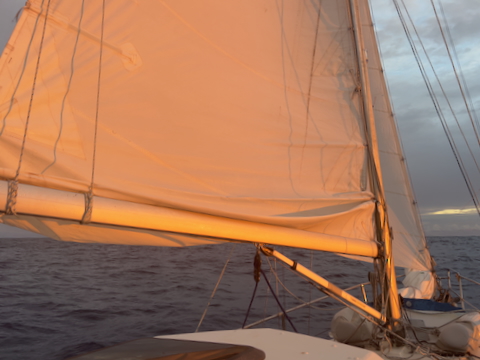
Wednesday, May 14, 2025
At midnight, the wind shifted, and to let the sails help the engine maintain speed at low RPMs around 5 knots, I temporarily bore away 10 degrees to the east.
In the morning, I could hold the desired course of 220 again, though the wind was no help at all. Even lowered the jib to stop it from luffing.
Later, I stowed the jib in its bag and raised the genoa. Until about noon, it worked, helping the Yanmar keep speed. Then the wind died again. Took down all sails. The apparent wind is purely head-on due to my own speed.
1,000 nautical miles left to Nouméa. At 5 knots, that’s about 8 days. It’d be great to get there by Friday to clear in before the weekend.
The next episode was a carbon copy of the first. It started to blow. Thinking the weather was turning, I looked at the horizon and took second reefs in the main. Lowered the genoa. Raised the jib. And then the wind died!
Damn it. Speed no more than 3 knots. At 9 PM, I started the engine again.
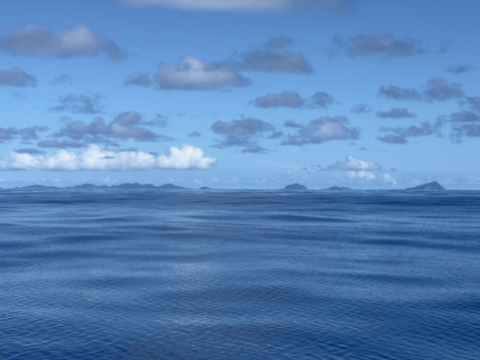
Thursday, May 15, 2025
Motorsailed until morning. Then had to stow the jib. The wind died completely. The ocean is like a mirror.
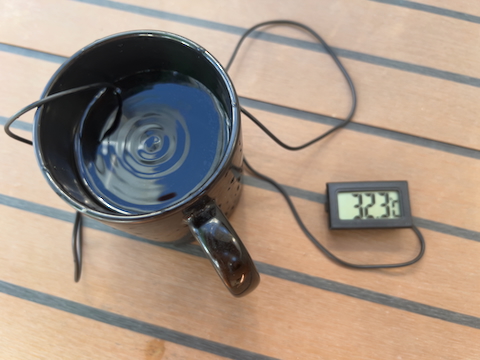
During the day, I measured the water temperature overboard: 32.3°C! Unreal! I’ve never seen ocean water this warm in my life! The cabin is at 36°C! That’s higher than it was at the equator — 35°C. Must be El Niño this year. That explains the tropical storms in May. It’s winter in the Southern Hemisphere, after all.
At the end of the day, I passed Rotuma Island, formally part of Fiji, abeam to port. Covered 2,500 miles. 900 left to New Caledonia.
Learned from Grok 3 that chess engines use Syzygy tablebases for endgames. They embed them in their binaries — not fully, but for the most common endgames. So, no need to reinvent algorithms. Just use the tablebases. Downloaded Fathom, a library for working with Syzygy tablebases. Built a test program. The C code wasn’t compatible with the M1 processor — it was written for Intel CPUs. Had to tweak it a bit. The interface is quite simple: three functions: initialize the tablebases and two calls. One gives you the result: draw, win, or loss. The other gives the correct move. Up to 7 pieces are fully calculated. So, no need to mess around with endgames. For up to 5 pieces, the tablebases take just 1 GB of disk space.
When it got dark, Rotuma Island vanished into the night — not a single light was visible, let alone any lighthouses.
I forgot to pour last two jerry cans of diesel into the tank, when it was still daylight. I had to do it with a flashlight. It is 100 liters of fuel in the tank now. Given that I would probably still need to motorsail overnight, 80 liters should last for about one and a half day at low RPM.
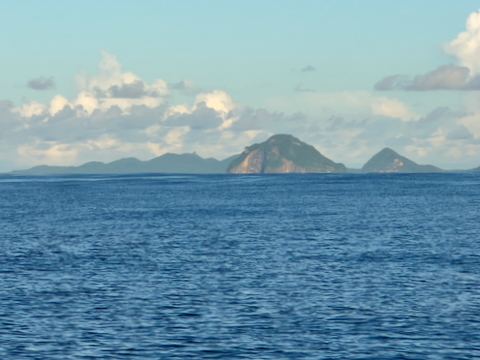
Friday, May 16, 2025
Until 1 AM, I was motoring, assisted by full sails. At 1, I woke up because a wave splashed through the open hatch into the cabin. Not too bad, just enough to snap me out of sleep.
Speed is 5.6 knots. So, a breeze is blowing. Shut off the engine, shook out the first reefs on the main. Beam reach. Port tack. Speed around 5 knots. That’ll do — need to conserve diesel. It might come in handy approaching New Caledonia. There, a low-pressure system is moving southeast, and the wind is expected to be light and following. That’s the forecast for next week, though. It’s likely not precise. But the low-pressure system is causing some concern, as it’s unclear where it’ll actually go.
If I recall the subtropical storm from two years ago, when Anton and I left Auckland and then took shelter from it in Opua in late May – early June, this feels very similar. I’ll keep an eye on the weather, assuming Starlink doesn’t let me down.
Woke up again around 5 AM — it was still dark. Sunrise is at 6:30. The sky is completely overcast; it looks like rain, or even a squall, could hit any moment. Took second reefs just in case. As dawn broke, I swapped the genoa for the jib. Sail work instead of morning exercise. Stowed the genoa in its bag this time. I probably won’t need it again. The next five days are forecast to bring easterly winds of 15-20 knots. Today and tomorrow are still cloudy, then sunny.
By noon, it was blowing hard. Speed over 7 knots. First, I took third reefs in the main. Then lowered the jib and raised the storm jib over it. Still hitting 7 knots in gusts! The forecast said 15-20 knots. Feels more like 25-30! After lunch, my nerves couldn’t take it — I lowered the main completely. Slow and steady wins the race. Speed is 4-5 knots under just the storm jib.
The rain is almost nonstop. Water’s back on the cabin floor again. And again, I can’t see where it’s leaking. Mood’s dampened. Starlink couldn’t find GPS coordinates for half an hour. Tomorrow weather will likely be the same, if not worse.
Covered 122 miles in the last 24 hours.

Saturday, May 17, 2025
Meteorologists, as often happens, got the wind speed wrong. I can’t say for sure how much they missed by since I don’t have an anemometer, but from years of sailing experience, I’d guess it was blowing over 30 knots. Sure, there were moments when it dropped to 20. At those times, speed under the storm jib was 3 knots. What do you think it takes to hit 6 knots? Most of the time, speed was 4-5 knots. Probably 25-30 knots then. So, the forecast error for 15-20 knots is 10 knots, or 50-75%! Imagine how hard it could blow when they predict 30 or 40 knots. That’s a proper storm, if not worse.
Normally, 15-20 knots is standard sailing weather. You take one or two reefs in the main, set the jib, and on a beam reach, like now, you’d expect boat speed of 5-6 knots without any drama. But when you’re forced to sail under just a storm jib, it’s always 30 knots or more.
Fiji Islands are 200 miles abeam to port, where I was with Anton and his family two years ago. I didn’t like it there. Tons of paperwork to fill out, even more money to pay for arrival clearance and a cruising license, plus following island customs — presenting kava to the local tribal chief, asking permission to anchor, and so on. It’s like the Stone Age. Some people enjoy it.
Ahead is Vanuatu’s Anatom Island, still 400 miles away. From there to Nouméa, it’s 250 miles.
At noon, the wind shifted, and the storm jib started occasionally flipping to the other side. Set it on a spinnaker pole. It doesn’t flip now and works better.
After lunch, the sun even peeked out. My mood lifted immediately. The weather seems to be improving. I’m considering switching back to the regular jib, also on a spinnaker pole. If a strong squall hits, it’s easy to drop by releasing the halyard. Unlike the main, which you have to wrestle down by hand while balancing at the mast. Raising it is simpler too — no need to head up. It just rolls the boat more than the main does.
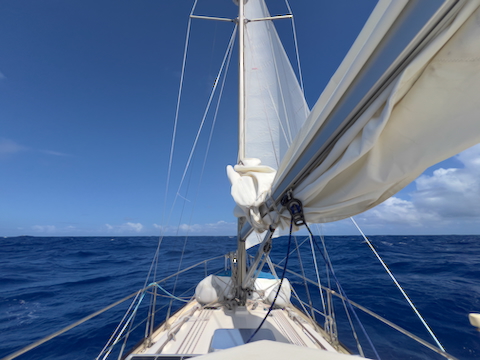
Said and done. Speed increased to 4-5 knots. Tomorrow, I’ll probably be able to raise the main.
It took Starlink 1 hour and 10 minutes to get GPS coordinates. Brutal.
By evening, the wind strengthened again. Speed became 5-6 knots — just what I needed.
Sunday, May 18, 2025
The night passed calmly, no squalls or rain.
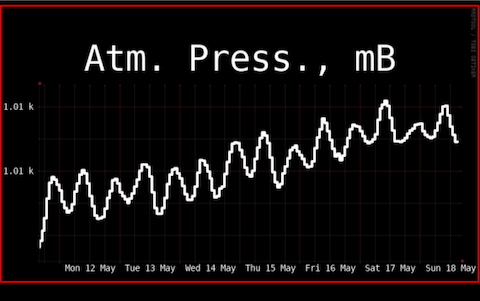
After lunch, the wind started to ease gradually, and speed dropped to 4-5 knots. The wind will continue to weaken, according to the forecast and the simple fact that I’m moving away from the equator — a low-pressure area — toward the 30th latitude, a high-pressure zone. This is clearly visible on the barometer. Pressure has been steadily rising all last week.
Raised a third of the main. Speed increased to 5-6 knots.
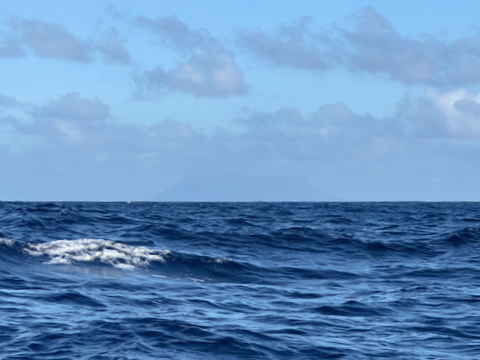
Monday, May 19, 2025
Woke up at 5 AM. Sunrise at 6:50. Battery voltage was at 12.34 volts. In other words, they’re about 60-70% discharged. The last three days, there was only sun yesterday, and even then, it’s not the same sun: it rises almost astern, so the 130-watt solar panel in front of the pilot house stays in the shade until noon; the sun doesn’t reach its zenith and sets abeam to starboard, where, on a port tack, the main casts a shadow on that same panel. In short, one panel is practically useless. Even without the fridge, the second, more powerful 200-watt panel at the stern isn’t enough to charge the batteries in these conditions.
Started the engine at idle to charge the batteries. Turned it off after 2.5 hours. The sun’s up now. It’ll take over where the Yanmar left off. Not a cloud in the sky.
As expected, the wind continues to ease. Shook out the third reefs on the main. Speed increased by half a knot — not much. Shook out the second reefs — speed at 5-6 knots — that’ll do for now, though it feels like I’ll soon need to shake out the first reefs too, and maybe swap the jib for the genoa.
Crossed 18° south latitude and 172° east longitude. Tomorrow evening, I’ll pass Anatom Island. Hoping to complete my solo circumnavigation Thursday evening. The round-the-world trip I finished last year in Martinique wasn’t entirely solo. Plus, it was very drawn out over time.
Closer to noon, I shook out the first reefs on the main.
Perfect yachting weather. Wind is around 15 knots. Light swell. Clear sky. Beam reach and speed around 6 knots.
It took Starlink 35 minutes to get GPS coordinates.
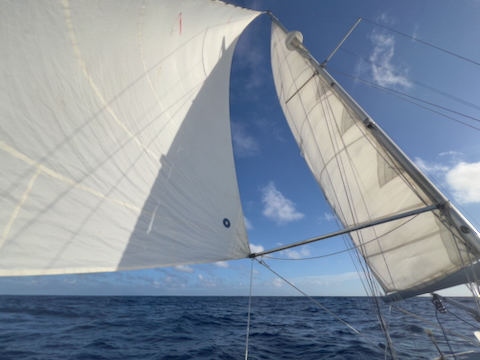
Tuesday, May 20, 2025
This morning, Vanuatu’s Futuna Island was clearly visible abeam to starboard. It looks very much like a giant volcano — not sure if it’s active or not.
By noon, the wind dropped to about 10 knots. Swapped the jib for the genoa. Without a spinnaker pole, it performs even worse than the jib with it. So, I had to fiddle with the spinnaker pole. Needed to extend it, moved the bolt to another position. Speed still 4-5 knots. Would prefer 5-6.
Anatom Island is now visible ahead on my course. It’s not as tall as Futuna but significantly larger in other dimensions.
For the first time this voyage, I rigged and cast a fishing line. Clearly, it’s not as hot anymore, and my appetite’s back.
It took Starlink 45 minutes to get GPS coordinates.
It was impossible to judge Anatom’s height. The island’s peaks were all shrouded in clouds.
At sunset, I got a bite! It was pulling hard and downward. I decided to wait a bit to let the fish, likely a tuna, tire out. Looking around, I realized I wouldn’t have to wait long. A black cloud was approaching. Meeting a squall with full sails isn’t exactly pleasant. Alright, time to hurry. Prepared the gaff, knife, and rum (for anesthesia). Started winding the line onto the yo-yo. Should’ve put on gloves... The fish kept pulling straight down. Only near the yacht did it start zigzagging. Yes, great tuna! Since it didn’t get away while I was reeling it in, I figured it wouldn’t escape if I pulled it aboard without the gaff. Handling a gaff alone is awkward — one hand pulling the fish, the other trying to hook it (not easy when the boat’s rolling), then dropping the reel to grab the gaff with both hands and haul the fish over the railing. The simplified procedure without the gaff or rum went well, except for my cut-up hands. Must’ve sliced them on the steel leader, and the tuna added to it with its sharp body parts while I tried to subdue it without anesthesia.
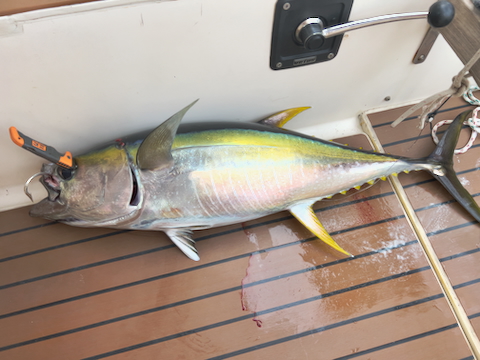
Managed to cut it into three pieces, put them in the galley sink, and quickly wash the cockpit before the cloud arrived. No strong wind, but I took a couple of reefs in the main just in case.
While I was further butchering the tuna and storing it in the freezer (had to use the big freezer, the small one couldn’t fit it all), the wind died. Started the engine. Then a slight breeze picked up, but the wind shifted, and the genoa on the spinnaker pole started luffing. Decided to take down the spinnaker pole. To do that, I had to lower the genoa. Should’ve shifted the engine to idle! The extended spinnaker pole, set for the genoa, went underwater, and the water pressure bent the thin aluminum tube in half because it caught on the shrouds, which acted like a lever. Now I understand why I always used a topping lift for the spinnaker pole! With it, the pole wouldn’t have gone underwater and would’ve stayed intact. Well, what’s done is done — no going back. Should’ve thought ahead. This is the second spinnaker pole breakage in my life. I don’t recall what happened the first time, but I’d already replaced the telescoping tube once.
Took down the spinnaker pole; the tube was easy to break — it practically snapped when I tried to straighten it. Stowed the genoa in its bag too. Tomorrow’s forecast is 15 knots, which seemed a bit much for the genoa.
An hour or so later, a beam reach picked up. Raised the jib. Shut off the engine.
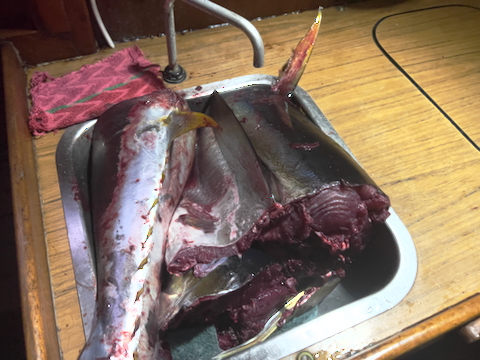
Wednesday, May 21, 2025
Woke up at 1 AM because the jib was in the main’s shadow and started flapping. The wind had shifted. Lowered the jib. Speed at 3 knots. Started the engine.
At 5 AM, another cloud arrived. It brought a decent breeze. Shut off the engine. One reef in the main was enough to handle the gusts. Speed reached 6.5 knots.
By dawn (7 AM local time, UTC+12), it wasn’t blowing as hard. Speed at 5-6 knots.
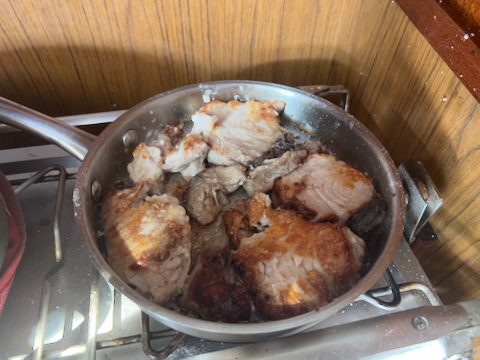
Nouméa operates in its own time zone, UTC+11, despite being at 166° longitude. I’ll switch to their time upon arrival. 180 miles left to Port Moselle Marina. At 5 knots, I’d arrive at 6 PM their time, but sunset is at 5:10, so it’ll be dark. Though I’ve been there before and saved my track for navigating the reefs and entering the marina, it’d still be better to arrive before dark. Need to shave off an hour somehow. The marina hasn’t confirmed if they have space. They asked for the yacht’s dimensions. Odd, since I told them I was there two years ago, hoping they’d have my yacht’s details on file.
Starlink took 41 minutes to acquire GPS coordinates.
For a few hours, I switched from the autopilot to the windvane for the first time this voyage. I didn’t want to reef the main to avoid losing speed, but the autopilot was oversteering, bearing the yacht away to a course more than 120 degrees off the wind, where the jib ended up in the main’s shadow. It was slow to bring her back on course. On such a borderline course (120 degrees to the wind), the windvane is more convenient. Even if it bears the yacht away, it quickly corrects back to course. It’s also handy for downwind sailing to prevent accidental gybes. Later, the wind shifted even more, so I had to lower the jib, and the windvane became pointless. It requires more attention, especially when the wind keeps changing.
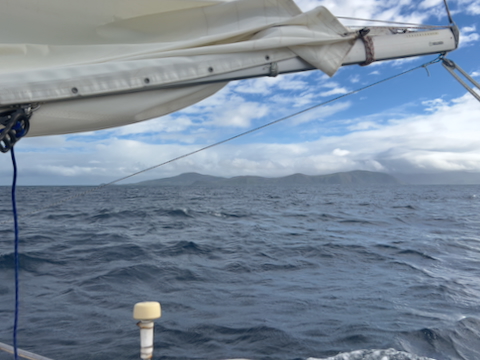
Under just the main, speed dropped to 3-4 knots. But thanks to a strong following current, the yacht was making 5-6 knots over ground. I caught this strong current near Maré Island, part of the Loyalty Islands in New Caledonia. The current was following before, but not 2 knots like here.
Checked the fuel level in the tank: three and a half jerry cans, or 70 liters. That should be enough to reach the marina at low RPMs. So, to arrive tomorrow before dark, I started the engine while the wind is weak and following, hoping it’ll shift later. Speed increased to 6-7 knots. The broad reach is partly due to this strong southern current — I have to steer the yacht 15-20 degrees to the right of the desired course. If the current stops, I can raise the jib again.
The marina booked me berth F030. They said to call them on the VHF at the marina entrance, and they’ll meet me to assist with docking. I warned them I plan to arrive before 6 PM but might be delayed. Asked just in case if anyone would be at the marina after 6 PM, and if not, how to find my berth. Hopefully, they’ll reply tomorrow. I’d mentioned earlier I might arrive after 6. There’s probably someone on duty at night, like security. I’ll check tomorrow if they have a marina map with berth numbers on their website. There should be one — it’s the French, not Americans!
At 5 PM, I passed 8 miles off the southeastern tip of Maré Island. It’s surprisingly flat, unlike the other mountainous islands in this region. 122 miles left to Nouméa. 70 miles to the Passe de la Sarcelle through the barrier reef. I should be there at dawn.
Thursday, May 22, 2025 - the end of solo circumnavigation
At 6 AM, I entered the Passe de la Sarcelle, thus completing my solo circumnavigation. Here’s some stats:
| From | To | Nautical Miles | Time |
|---|---|---|---|
| Nouméa | Darwin | 3,920 | 23 days |
| Darwin | Pointe des Galets | 4,478 | 39 days, 4 hours |
| Pointe des Galets | Richards Bay | 1,430 | 11 days, 13 hours |
| Richards Bay | East London | 328 | 2 days, 2 hours |
| East London | Port Elizabeth | 113 | 21 hours |
| Port Elizabeth | Cape Town | 417 | 3 days |
| Cape Town | St. Helena | 1,708 | 13 days, 23 hours |
| St. Helena | Ascension Island | 706 | 6 days, 13 hours |
| Ascension Island | Martinique | 3,091 | 24 days, 9 hours |
| Martinique | Bonaire | 470 | 3 days, 18 hours |
| Bonaire | Curaçao | 35 | 7 hours |
| Curaçao | Aruba | 56 | 12 hours |
| Aruba | Panama | 654 | 5 days, 7 hours |
| Port Cristóbal | Panama City | 42 | 10 hours |
| Panama City | Hilo | 4,619 | 37 days, 21 hours |
| Hilo | Honokohau | 102 | 22 hours |
| Honokohau | Maalaea | 72 | 14 hours |
| Maalaea | Honolulu | 85 | 19 hours |
| Honolulu | Nouméa | 3,394 | 30 days, 10 hours |
| Total | Average speed 5.2 knots | 25,720 | 6 months, 22 days (205 days), 9 hours |
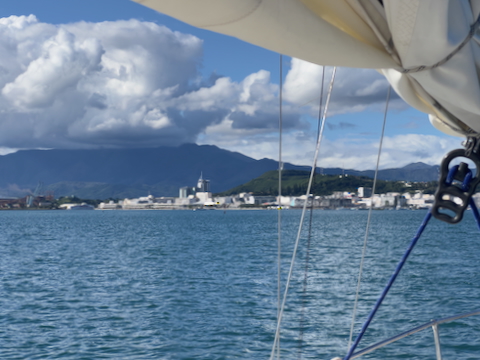
New Caledonia greeted me with a low-pressure system. Its congratulations came in the form of gusty winds over 30 knots (forecast was 15-20), constant squally clouds, and rain.
Only on the approach to Nouméa did the weather clear up. The sky cleared, and the wind either died down or couldn’t get through the mountain ridges of the main island.
I approached the marina around 3 PM local time. Switched my clock to UTC+11. Contacted Port Moselle on VHF channel 67. They met me at the dock and helped with mooring. There was no wind, so I could’ve done it myself, but finding my berth would’ve been tough since the main piers are marked with letters visible from the sea, but the berth numbers themselves aren’t visible from the water. The berth number signs are nailed to the dock and only visible from there. The marina map on their website shows only pier letters, not berth numbers. You also need to know which side of the pier has even or odd numbers. Since I was at berth 15 on the left side of the pier last time (looking from the sea), it made sense that berth 30 would be on the right. And it was. But honestly, if they meet you, does it matter? They answered my question about arriving after 6 PM, saying it’s better to take a buoy and wait until morning.
No issues with clearance, same as last time. Still need to fill out four forms: one for the marina, one for immigration, one for customs, and one for biosecurity.

Biosecurity comes to the yacht first. They’re mainly interested in fresh vegetables, fruits, meat, etc. Naturally, after a month at sea, I had none left. I offered the inspector some tuna, but he declined. Odd, last time they took fish eagerly. I offered a mahi-mahi head, knowing it’s valued in Polynesian culture, and the inspector also took another big piece of his choice. That threw me off a bit, but oh well, no big deal. Maybe that’s why he didn’t last long in the job? Today’s inspector flat-out refused the fish. And I was counting on him taking some — I doubt I can eat that much myself.
Still need to visit immigration in the morning. They’re open from 8 to 11:30 AM. The marina sends my customs form for me. I’ll only need to visit customs when departing, plus visit the port captain then.
All I managed to do by the end of the day was ride a bike to Auchan and buy fresh food. It was already dark when I got back to the yacht.
It’s nice to be back in a welcoming marina where I can plug into shore power and not worry about battery charge for the fridge or Starlink. Like last time, they gave me a voucher for a free drink at the bar, but no code for free Wi-Fi — either they forgot, or it’s not free anymore. I’m not too upset since I can use Starlink. I wasn’t thrilled with the bar’s breakfast last time, so I decided not to go, despite the free drink.
One last week-long passage to Brisbane remains. After that, if I can successfully stay in Australia, I’ll take a break from long voyages for a while. Time to get back to work!
All pictures from New Caledonia are on Google Photos.

